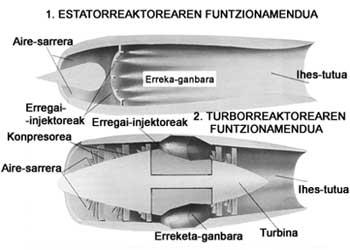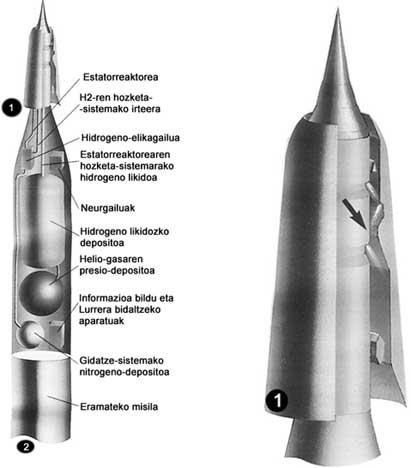Statorreactors in aircraft
Faster and faster planes
To warn of this speed, it can be said that the sound at sea pressure has an air speed of 341 m/s and runs 1.227,6 kilometers per hour. This speed is by definition the speed of Mach 1, and they are extremely sinks that circulate faster.
If the current normal planes take eighteen hours from New York to Tokyo, the superrestatorreactor plane would travel three hours at a speed of Mach 6. It must be clarified that the Russians, prepared a superrestatorreactor at the research center for aviation engines, have reached the speed of Mach 6 at the Baikon cosmodrome. This speed of 7.365.6 km/h remained last year in 130 seconds on a 180 km flight.
For American experts it has been a surprise. Despite this year having a budget of 260 million dollars for aerospace aviation, in another three years they do not plan to carry out such tests.
The path of the statorreactor is the path by which the Concorde Europe or the American Boeing 747 must follow within about twenty years. For the supply of intercontinental lines, 6-speed Mach aircraft are already being designed. These vehicles would circulate through the upper layers of the atmosphere (stratosphere) and serve to put into orbit some apparatus. The superrestatorreactor is the ideal engine for these aircraft, known in North America as Scramjet.
New engine and heat
A major obstacle to this new reactor is that combustion is performed at moderate or hypersonal speed. Although the outside air slightly decreases its speed of entry to the engine, the combustion chamber has a speed of Mach 4.
M. Russian Research Officer Mr. Ogorodnikov indicates that the performance of the usual statorreactor (usually burning is performed at speeds below those of sound) decreases considerably as they approach hyjonic speeds (Mach 6). Between the air inlet and the combustion chamber shock waves are generated with excessive temperatures and pressures in the combustion chamber. This implies greater mechanical strength in the combustion chamber and an ineffective push of the reactor.
This decline in performance is due to two factors. On the one hand, mechanical energy degrades with shock waves and on the other, the thermal balance of combustion decreases. In addition, at high temperatures the reagents of the fuel are dissociated. Therefore, if you want to avoid these problems, the flow of gases in the statorreactors must be maintained at speeds lower than those of sound.
Soviet brands
However, today it seems that the Russians also dominate the supplanted flows. In fact, the Soviets have been working on these issues for some time. In the 1920-30's they experimented with planes and launchers. Tsander, S.A. Stechkine and V.I. Based on studies by Dudakov.
Yu in 1939. Pobedonovstev and I. A. The statorreactor of military engineer Merkulov was tested on a Pollikarpov I-152 aircraft. Later, 2 January 1940, P. Ye The pilot Loginov flew for the first time in the world at the Frunze airfield in Moscow on the plane I-152 with the statorreactor DM-2. 140 additional flights with statorreactors DM-2 and DM-4.
After that, the Second World War paralyzed all the sessions and after the hard times of Stalin again took up this subject. E., assistant to Sergei Paulovitx Korolev (famous spaceist). S. Professor Txetnikov established the theoretical basis for motor combustion at supposed speed and in 1958 patented the system. The Soviets did not then think that this engine could not be used on planes, as its engine was designed for hysterical missiles.

New statorreactor
However, on November 28, 1991, this engine was used in a civil manner, beating the existing brands. What they have used is the liquid hydrogen statorreactor. In the previous section, the problems of the statorreactors in the cooking chamber have been mentioned and these and others have been dominated by the Russians.
M. According to the manager Ogorodnikov, the engine only works at speeds over 3,500 km/h, which means that the introduced air is heated to 2,000 ºC. Liquid hydrogen has been the most suitable to overcome problems in all tested fuels, as in addition to generating few problems of injection and evaporation, it is the one with the greatest energy capacity. It has been proven to burn well in subsonic and supersonal flow (both).
They had to test the engine on an atmospheric flight. It is not possible to perform ground tests imitating conditions at Mach 6 speed. Computer simulations could also be performed, but the aerial test was the safest to check the calculations.
Russian test
At the Baikoniz cosmodrome, the statorreactor was launched in a four-speed ground/air missile. The “superrestatorreactor” maintained the speed of Mach 6 in 130 seconds or 180 kilometers. They had to design the whole test: a mission with capos, the engine itself, its operation, cooling, etc.
The motor is symmetrical. with different stages of air compression, variable diameter combustion chamber and short exhaust pipe. The air inlet hole is 0.23 meters and a total length of 1.28 meters. The engine turns on automatically when it reaches Mach 3 speed and remains stable in all operating regimes.
The combustion chamber of the statorreactor has been designed for two operating regimes. At “low” speeds (Mach between 3 and 5), hydrogen burns at subsonic speed, but the combustion gas moves at hypersonal speed between Mach 6 and 8. Hydrogen is fed through multi-grooved injectors that operate at different speeds.
The statorreactor was placed at the end of a launcher, with 250 sensors and meters on the same projector. It also had fuel feeders and cryogenic system mounted to keep liquid hydrogen at -253°C. Computer memory also worked to save measurements and the transmission system to Earth.
This trial has proven the dynamics and technology of gas. Parameters of air inlet, combustion chamber, control equipment, feeding regulation, tube cooling and full motor have been established.
The most difficult task is to supply and power this engine to -235 degrees Celsius of liquid hydrogen. They had to invent a new system.
The push exercised by the statorreactor ranges from 200 to 500 kilograms. In the cooking chamber the temperature ranges between 1,500-1,800 degrees and the pressure is 1 or 2 atmospheres.
As has been proven in the tests carried out so far, the engine works perfectly in both regimes (subsonic and superpersonal). As a result, the superrestatorreactor can replace pitchers that operate in stages. These launchers can only be used once and aerospace planes as many times as they want.
In the future what?
The Russians are about to develop this very satisfying path. They want to test the statorreactor for a Mach 10 speed (12,276 km/h) at a height of 35 kilometers. They also intend to test with statorreactors of different geometry, using a shooter greater than the current one.
In Russia, however, economic problems are difficult and have a great lack of money to develop these programs. As a solution is to find funding abroad, they have taken some steps in North America and other states.






